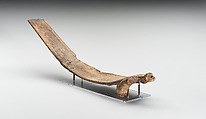Returned to lender The Met accepts temporary loans of art both for short-term exhibitions and for long-term display in its galleries.
Duho (Ceremonial Seat)
Not on view
Click READ MORE for English
Los hombres y las mujeres poderosas utilizaban elegantes bancas de madera como tronos portátiles. La forma de estos ejemplos con diseños geométricos imita la forma de una hamaca de fibras. Las cabezas y extremidades revelan la visión del escultor de las identidades de cemíes que habitaban el interior de la madera original. Los gobernantes o sus descendientes depositaron estos duhos en cuevas en las Bahamas, la región que constituye el límite septentrional en que vivieron las civilizaciones taínas.
Powerful men and women used graceful wooden seats (duhos) as portable thrones. These two examples with incised geometric designs mimic the swooping shape of fiber hammocks. Protruding heads and limbs reveal the sculptor’s vision of the zemí identities that inhabited the original wood. The caretakers of these duhos or their descendants ritually deposited these seats in caves in the Bahamian (or Lucayan) archipelago, which was in the northernmost region inhabited by Taíno civilizations.
This image cannot be enlarged, viewed at full screen, or downloaded.
This artwork is meant to be viewed from right to left. Scroll left to view more.








